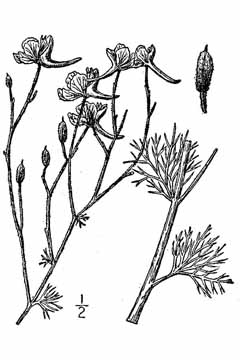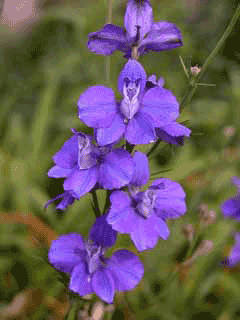 |
|
USDA-NRCS PLANTS Database / Britton, N.L., and A. Brown. 1913. An illustrated flora of the northern United States, Canada and the British Possessions. Vol. 2: 94. |
 |
| http://flickr.com/photos/carllewis/ Consolida regalis |
Translate this page:
Summary
Bloom Color: Blue, Pink, Purple, Red, White. Main Bloom Time: Early summer, Late summer, Late spring, Mid summer. Form: Upright or erect.
Physical Characteristics

 Consolida ambigua is a ANNUAL growing to 1 m (3ft 3in) at a fast rate. It is in flower from July to August. The species is hermaphrodite (has both male and female organs) and is pollinated by Bees, Lepidoptera (Moths & Butterflies). The plant is self-fertile.
Consolida ambigua is a ANNUAL growing to 1 m (3ft 3in) at a fast rate. It is in flower from July to August. The species is hermaphrodite (has both male and female organs) and is pollinated by Bees, Lepidoptera (Moths & Butterflies). The plant is self-fertile.
Suitable for: light (sandy), medium (loamy) and heavy (clay) soils and prefers well-drained soil. Suitable pH: mildly acid, neutral and basic (mildly alkaline) soils. It can grow in semi-shade (light woodland) or no shade. It prefers moist soil.
UK Hardiness Map
US Hardiness Map
Synonyms
C. ajacis.
Plant Habitats
Cultivated Beds;
Edible Uses
Edible Parts: Oil
Edible Uses: Oil
None known
References More on Edible Uses
Medicinal Uses
Plants For A Future can not take any responsibility for any adverse effects from the use of plants. Always seek advice from a professional before using a plant medicinally.
Parasiticide Parasiticide Vulnerary
Larkspur formerly had a reputation for its ability to consolidate and heal wounds[244], whilst the juice from the leaves is considered to be a remedy for piles and an infusion of the flowers and leaves has been used as a remedy for colicky children[244]. However, the whole plant is very poisonous and it should not be used internally without the guidance of an expert. Externally, it can be used as a parasiticide[207]. A tincture of the seed is applied externally to kill lice in the hair[240].
References More on Medicinal Uses
The Bookshop: Edible Plant Books
Our Latest books on Perennial Plants For Food Forests and Permaculture Gardens in paperback or digital formats.

Edible Tropical Plants
Food Forest Plants for Hotter Conditions: 250+ Plants For Tropical Food Forests & Permaculture Gardens.
More

Edible Temperate Plants
Plants for Your Food Forest: 500 Plants for Temperate Food Forests & Permaculture Gardens.
More

More Books
PFAF have eight books available in paperback and digital formats. Browse the shop for more information.
Shop Now
Other Uses
Insecticide Oil Parasiticide Parasiticide
The seed is insecticidal[240]. A tincture made from the seed is said to be effective against hair nits[244]. There is uncertainty as to whether the insecticidal effect is due to the oil or alkaloids in the seed[240]. The seed contains 39% of a fixed oil, though the report does not say if this is ever exploited[240].
Special Uses
References More on Other Uses
Cultivation details
Landscape Uses:Border, Container, Foundation, Massing, Woodland garden. An easily grown plant, it prefers a sunny position in a well-drained soil. This species is called Consolida ajacis by some botanists[274]. Larkspur is a greedy plant, inhibiting the growth of nearby plants, especially legumes[54]. Plants resent root disturbance and should not be transplanted[200]. Special Features:Attractive foliage, Naturalizing, Suitable for cut flowers, Suitable for dried flowers.
References Carbon Farming Information and Carbon Sequestration Information
Temperature Converter
Type a value in the Celsius field to convert the value to Fahrenheit:
Fahrenheit:
The PFAF Bookshop
Plants For A Future have a number of books available in paperback and digital form. Book titles include Edible Plants, Edible Perennials, Edible Trees,Edible Shrubs, Woodland Gardening, and Temperate Food Forest Plants. Our new book is Food Forest Plants For Hotter Conditions (Tropical and Sub-Tropical).
Shop Now
Plant Propagation
Seed - sow in succession from spring to early summer in situ. Germinates in 2 - 3 weeks[200]. Seedlings transplant badly[200]. An autumn sowing can succeed in areas with mild winters[200]. The seed has a short viability and should not be stored for more than one season[200].
Other Names
If available other names are mentioned here
Native Range
TEMPERATE ASIA: Cyprus, Turkey EUROPE: Ukraine (Krym), Albania, Bulgaria, Bosnia and Herzegovina, Greece (incl. Crete), Croatia, Italy, North Macedonia, Montenegro, Romania, Serbia, Slovenia, France (incl. Corsica)
Weed Potential
Right plant wrong place. We are currently updating this section.
Please note that a plant may be invasive in one area but may not in your area so it's worth checking.
Conservation Status
IUCN Red List of Threatened Plants Status :

Growth: S = slow M = medium F = fast. Soil: L = light (sandy) M = medium H = heavy (clay). pH: A = acid N = neutral B = basic (alkaline). Shade: F = full shade S = semi-shade N = no shade. Moisture: D = dry M = Moist We = wet Wa = water.
Now available:
Food Forest Plants for Mediterranean Conditions
350+ Perennial Plants For Mediterranean and Drier Food Forests and Permaculture Gardens.
[Paperback and eBook]
This is the third in Plants For A Future's series of plant guides for food forests tailored to
specific climate zones. Following volumes on temperate and tropical ecosystems, this book focuses
on species suited to Mediterranean conditions—regions with hot, dry summers and cool, wet winters,
often facing the added challenge of climate change.
Read More
Expert comment
Author
(L.)P.W.Ball.&Heyw.
Botanical References
200
Links / References
For a list of references used on this page please go here
Readers comment
© 2010, Plants For A Future. Plants For A Future is a charitable company limited by guarantee, registered in England and Wales. Charity No. 1057719, Company No. 3204567.